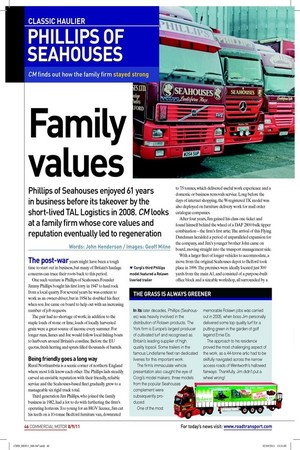Family values
Page 39

Page 40

If you've noticed an error in this article please click here to report it so we can fix it.
Phillips of Seahouses enjoyed 61 years in business before its takeover by the short-lived TAL Logistics in 2008. CM looks at a family firm whose core values and reputation eventually led to regeneration Words: John Henderson / Images: Geoff Milne The post-war years might have been a tough time to start out in business, but many of Britain’s haulage ▼ Corgi’s third Phillips concerns can trace their roots back to this period. model featured a Rolawn One such venture is Phillips of Seahouses. Founder liveried trailer
Jimmy Phillips bought his irst lorry in 1947 to haul rock from a local quarry. For several years he was content to work as an owner-driver, but in 1954 he doubled his leet when son Joe came on board to help out with an increasing number of job requests.
The pair had no shortage of work; in addition to the staple loads of stone or lime, loads of locally harvested grain were a great source of income every summer. For longer runs, James and Joe would follow local ishing boats to harbours around Britain’s coastline. Before the EU quotas, fresh herring and sprats illed thousands of barrels.
Being friendly goes a long way
Rural Northumbria is a scenic corner of northern England where most folk know each other. The Phillips lads steadily carved an enviable reputation with their friendly, reliable service and the Seahouses-based leet gradually grew to a manageable six rigid truck total.
Third generation Jim Phillips, who joined the family business in 1982, had a lot to do with furthering the irm’s operating horizons. Too young for an HGV licence, Jim cut his teeth on a 10-tonne Bedford furniture van, downrated to 7.5 tonnes, which delivered useful work experience and a domestic or business removals service. Long before the days of internet shopping, the W-registered TK model was also deployed on furniture delivery work for mail order catalogue companies.
After four years, Jim gained his class one ticket and found himself behind the wheel of a DAF 2800 bulk tipper combination – the irm’s irst artic. The arrival of this Flying Dutchman heralded a period of unparalleled expansion for the company, and Jim’s younger brother John came on board, moving straight into the transport management side.
With a larger leet of longer vehicles to accommodate, a move from the original Seahouses depot to Belford took place in 1996. The premises were ideally located just 300 yards from the main A1, and consisted of a purpose-built ofice block and a sizeable workshop, all surrounded by a good-sized yard complete with secure warehousing. The property was ideal for the irm’s remaining 12 years in operation, and accommodated a leet that peaked at around 18 vehicles. Articulated combinations predominated from the late 1980s, but the irm always kept a couple of rigid tippers for its long-standing local quarry work.
In road transport terms, Seahouses is a relatively isolated location where appointed truck dealerships are concerned and Phillips’ buying policy was based, to a certain extent, on the strength of working relationships with the relevant salesmen. The importance of personal connections was equalled by the criteria of repair and maintenance packages in later years, together with the location of nearest dealerships and vehicle performance. DAF’s 2800 and 3300 models played an important part in the irm’s development and are remembered as being true workhorses. These stalwarts were followed by three 95 series and four 85 types, but a move from Newcastle to Birtley put additional mileage between this operator and his DAF dealer, reducing the marque’s presence at Phillips. The irm’s mixed purchasing policy paid dividends over the years, as speciic models from ERF, MAN and Mercedes-Benz proved highly successful. The Sandbach builder’s E-Series was considered the ultimate ‘gaffer’s motor’, which subsequent ERF models never quite matched. MAN’s long-running F-Series product was bullet-proof in a variety of power or wheelbase conigurations, while a 2002-registered Mercedes-Benz Actros 2543 prime mover was possibly Phillips’ most reliable truck. Volvo made its mark during the irm’s last decade, with the manufacturer’s FH Globetrotter cab a irm favourite with long-distance drivers. Superb back-up levels and the relatively close proximity of Blyth’s Volvo Truck & Bus Centre, Phillips’ closest dealership, were valued by the haulier.
Keeping cargos varied
Multi-palletised loads of agricultural and food products were regular cargos for Phillips (Seahouses), in addition to paper, timber and chemicals. Curtainsiders formed the majority of trailer types, complemented by a couple of platform examples, which were maintained in-house by a full-time mechanic. Onboard fork-lift trucks were itted to some trailers for specialised turf deliveries.
A diverse range of destinations saw Phillips’ signature red and maroon livery spotted across the UK, and it wasn’t unusual to have one truck in Wick and another in London on any given working day.
In April 2008 Jim Phillips decided to sell his operation to the TAL Logistics Group. Commercially, Phillips (Seahouses) was in good shape with no debt, money in the bank, and plenty of work for its leet of vehicles. At that point Jim just wanted out of the rat race, as the business had grown to a size where it was taking up his every waking hour.
However, the controversial TAL Logistics operation lasted only two years before being placed into administration in April 2010 and it is somewhat ironic that two months before they went down, Jim Phillips declined the chance to buy the troubled Shefield-based group for just £1. n












































